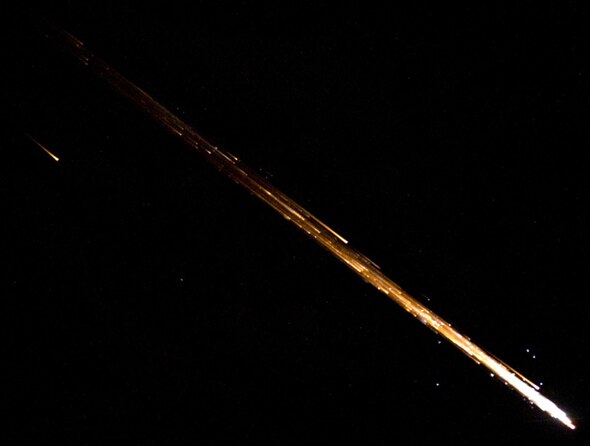Create a free profile to get unlimited access to exclusive videos, sweepstakes, and more!
Why Yes, It Is Exactly Rocket Science!

A little while back I posted an amazing Vine video taken by an astronaut on the International Space Station. It shows the release of the Cygnus cargo resupply ship Janice Voss, which had finished its mission bringing supplies up to the ISS. It was filled with trash, unberthed using the robotic CANADARM 2, then put into an orbit that would drop it into Earth’s atmosphere to burn up over the Pacific Ocean.
In the video, the Voss looks like it goes up, into a higher orbit than the ISS, which I thought might be due to the use of a wide-angle fisheye lens. I also supposed it might be due to the orbit of the ship. Watch the video:
So, what’s going on? I got an email from someone who knows orbital mechanics (but prefers to remain anonymous), and he confirmed my suspicions. To explain, I need to give you a brief intro to orbital mechanics. It’s not like the movies … and let me note that I’m no expert in orbital mechanics, so if I make an error here it’s mine, and not my source’s. I’m also going to leave out some details that are a bit hairy, but if you like, you can read up on how orbital mechanics works. It’s pretty cool.
When an object is in orbit around the Earth, its velocity is dependent on how far it is from the center of the Earth (the orbital radius) and the shape of its orbit. For a circular orbit, the orbital radius doesn’t change, so the velocity is constant. If you increase the radius (its distance from Earth) the velocity slows down, so a circular orbit with a larger size means the spacecraft orbits more slowly.
If you want to get to a higher orbital radius, you point your spacecraft into the direction it’s heading and ignite the rocket. The thrust adds velocity to spacecraft for a short time. But that doesn’t put it in a bigger circular orbit; the added energy stretches out the orbit, making it elliptical. The highest point of this new orbit (called apogee) is above the old circular orbit, and the lowest point (perigee) just meets the old one (the old-fashioned term for this is “osculating,” which means “kissing,” a delightful use of the word).
So what does this mean for the ISS and Voss? They start off moving at the same speed, because they’re connected. Voss faces forward, disconnects, and ignites its thruster. The added energy puts it on an elliptical orbit, and it immediately goes up into a higher orbit than ISS; that’s what we see in the video, and why Voss appears to move away from Earth. That’s because it does move away!
Now, if that’s all there was to it, one orbit later Voss and ISS would meet up once again when Voss reaches perigee. But we don’t want that! The whole point is get the spacecraft away from the ISS. So how did they do that?
Watch the video again. Just before the burn, Voss dips its nose a little bit, pointing it slightly down toward the Earth. So it wasn’t thrusting exactly tangent to its orbit; the rocket pushed it down a bit. That maneuver also affects the shape of the elliptical orbit, changing where Voss will reach perigee, and also dropping perigee a bit lower. One orbit later, when Voss reaches perigee, it will be ahead of and lower than ISS. That prevents any chance of collision, even if the spacecraft loses power; the orbits no longer cross.
That would be the situation forever if nothing changed. However, the endgame here is to drop Voss into Earth’s atmosphere. So, a couple of days later, after engineers made sure everything was kosher, they made a final maneuver. They turn Voss around, so now it’s facing backwards in its orbit (tail first). The rocket is fired again, which drops the apogee of the orbit to inside that of ISS, again preventing a collision. The perigee also drops, and the burn lasts long enough so that at perigee the Voss is inside Earth’s atmosphere.
Half an orbit later Voss reaches perigee, and Earth’s air now has a large drag effect. It steals energy from the orbit, dropping the spacecraft even lower. At that point, atmospheric drag really takes over, and you get the spectacular fireball as the ship hypersonically rams the air in front of it, compressing it, and heating it up hugely. The ship becomes a human-made meteor, and falls into the ocean (where, I suppose, it becomes a human-made meteorite).
Tadaaa!
I find orbital mechanics fascinating, because it all works following (relatively simple) rules that only seem counterintuitive (I had the devil’s own time understanding this video until I realized the Voss was on an elliptical orbit; the mechanics suddenly became way easier to understand). That’s OK, as long as you don’t fret over the instincts humans have developed over millions of years living on the ground.
Flying into space we put centuries of math to the test … and it works. It works. That to me is one of the most amazing things about science that there is: The Universe obeys a set of rules, and we can figure them out. And in many cases, we truly have.


























